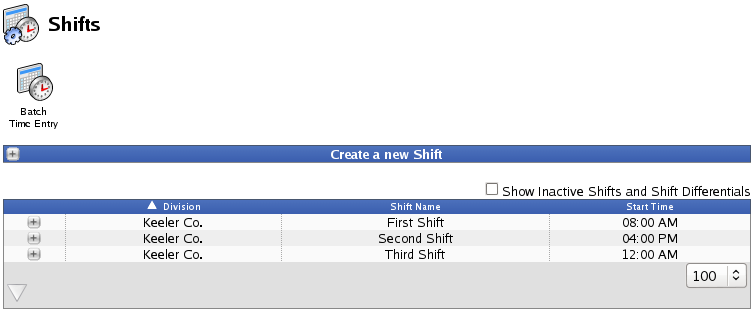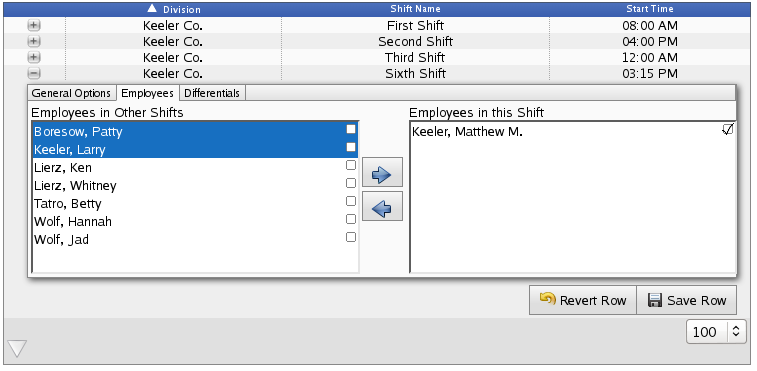
|
|
Applies to versions: 1.11, 2.0, 2.1, 2.2, 2.3
Shifts
Shifts are used in conjunction with Batch Time Entry to provide a way to enter time worked in blocks for multiple employees and multiple days at a time. Time can be entered by hand or imported from a csv file using Batch Time Entry. Create a shift for each time of day that you need to enter/import time. For example, first shift might be at 8:00AM, second shift at 4:00PM and third shift at 12:00AM.
- A way to manually enter time in batches
- A way to apply differentials or special pay types for durations of time in a day, week, etc.
Using the left pane Main Menu » Administration, click on: Schedules » Shifts
- or -
Using the left pane Main Menu » Administration, click on: Clocking » Batch Time Entry
and then click on the Shifts Administration icon  at the top of the page. at the top of the page.

Create a New Shift
- Click the + (plus) sign on the left hand side of the Create a new Shift bar.
- Type in the Name and Start Time.
- Click the Create button.
NOTE: Created shifts can be deactived, but not deleted.

Edit Shift
- Click the + (plus) sign to the left of the shift.
- From the General Options tab, the Name and Start Time can be changed.
- Click the Deactivate Shift button if this shift is not currently needed.
NOTE: Deactivated Shifts or Differentials are hidden by default. Check the box above the table to Show Inactive Shifts and Shift Differentials in the table below.
- Click the Save Row button.

Add Employees to a Shift
- Click the + (plus) sign to the left of the shift.
- From the Employees tab, click the employee's name to hightlight it and then click the arrow pointing right to move them to this shift.
TIP: Hold down the Control key to highlight and move mulitple employees at once.
- If there is a checkmark in the small box to the right of the employees name, they have a shift history. Click the box to view history.
- Click the Save Row button.

Create a Shift Differential
- Click the + (plus) sign to the left of the shift.

- From the Differentials tab, click the Add Differential button.

- Add a Name and Effective date/time for the new differential, then click Save.
Edit Differential
The Differentials tab allows setting spans of time that are paid in special ways.

- Click the + (plus) sign to the left of the differential to expand the window and set the terms.
- You can update the Name of this differential which is used in descriptions and reporting.
- You can change the optional Code Name which is used in Custom Payroll and Reports.
- Pick the Start Date and Time this differential will apply.
- The Differential Duration defines how long the differential will apply. If Repetition Period is set, the differential applies for this duration at the beginning of each repetition period.
NOTE: The duration is NOT adjusted for DST. This means that the duration spans the DST hour for an empolyee in a DST time zone, the total duration will always be as configured. The duration will not be shortened or lengthened by a DST shift.
- The Repetion Period allows the shift differential to occur repeatedly. To have it occur daily, enter 24:00:00. To have it occur weekly, enter 168:00:00. The repeat duration is adjusted for DST. This means that the repeat will be shortened or extended an hour as necessary if the employee is in a DST time zone to allow the differential to occur at the same time each day.
- If the Repetion Period rule eventually needs to end, set the Repetition End Date. After this time, the rule will no longer repeat, will not be active, and will no longer appear in the Differentials list.
-
The Qualifying Start Offset is the number of hours from the beginning of the shift, used to define the starting point of the qualifying duration.
-
The Qualifying End Offset is the number of hours from the end of the shift, used to define the ending point of the qualifying duration.
-
The Qualifying Time Percentage is the minimum percentage of each time segment that must fall within the above specified qualifying duration to be considered for this differential. Set to 0.0 to disable.
- If there is a specific pay rate (such as $10/hour) for time worked during the differential, enter it as the Hourly Rate.
- If there is a specific differential amount (such as $2.00/hour) which is paid in addtion to the standard pay rate, enter that as the Differential.
- If the differential time worked is a multiple of the standard pay rate, enter that as the Rate Multiplier. For example, enter 1.5 to pay at 150% of the employee's standard pay rate.
- Choose the Pay Type for work done during this differential.
- Decide whether or not the time worked during this differential will Count Toward Overtime for the week.
NOTE: The "Pay Type" and "Counts Toward Overtime" settings require the IPSOTO Overtime Options module if you would like any setting other than Default. When calculating payroll, the settings for differentials and pay types are done in order as follows:
- Per-event override, job override, holiday override, shift override.
- For Pay Type, Counts Toward Overtime and pay rate, the result will be the first override that's found, going in order of priority.
- For Differentials, the amounts are added for each, in order of priority.
- Click the Save Row button.
Was this article relevant to your question? Yes No |

 Information
Information Sales
Sales Support
Support





